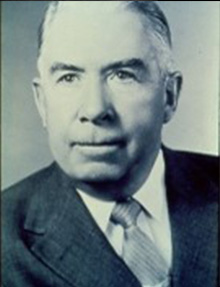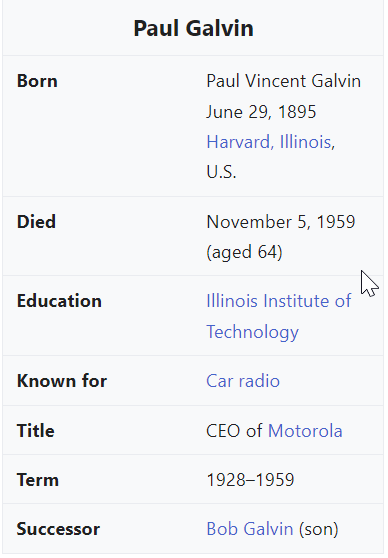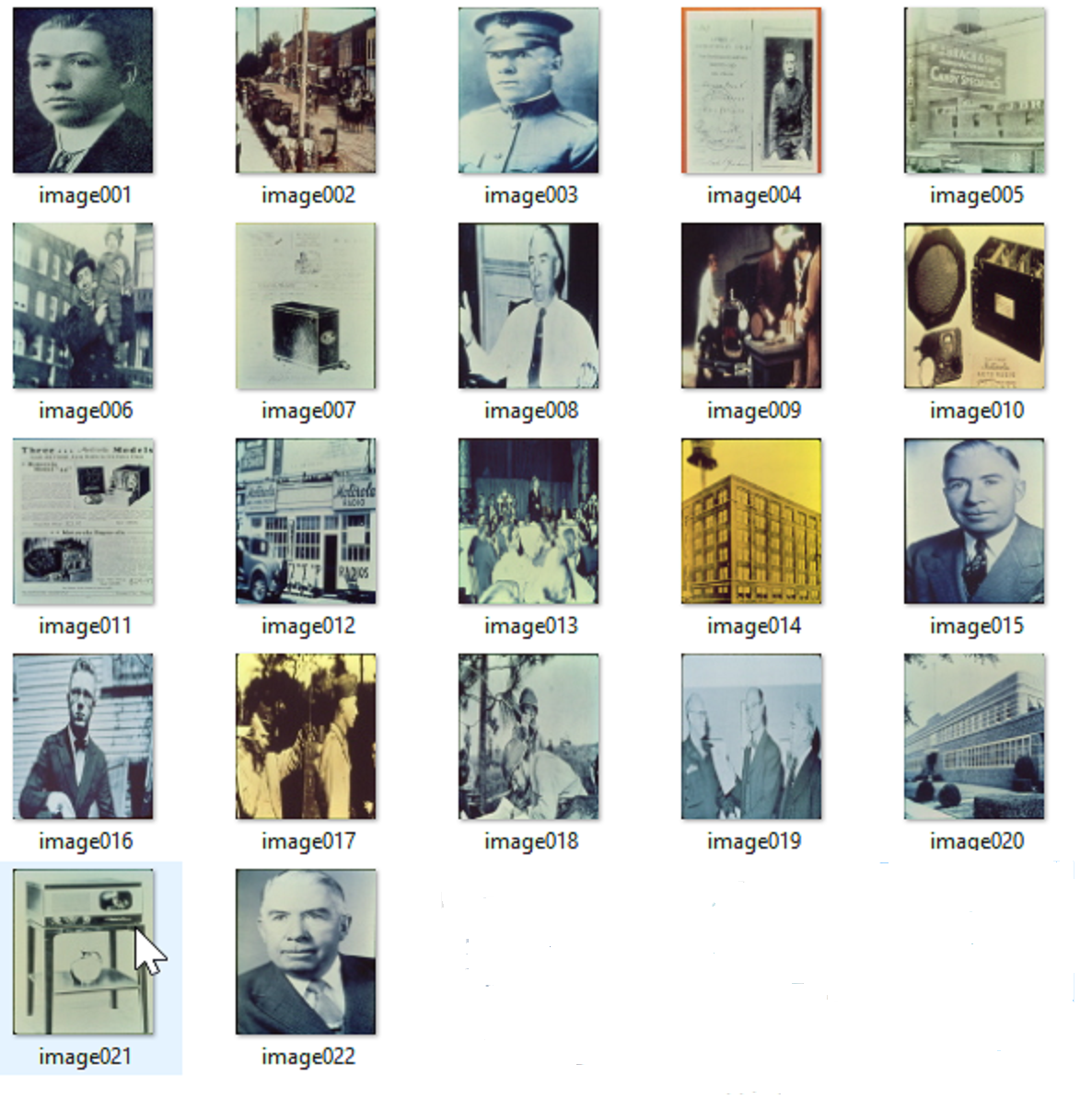Paul Galvin -- Motorola

Click for PDF version of Paul Galvin -- Motorola -- Biography
Introduction
 Picture of Paul Galvin - Motorola
Picture of Paul Galvin - Motorola
 Picture of Paul Galvin Life Stats
Picture of Paul Galvin Life Stats
Paul_Galvin_(businessman) -- Wikipedia page
Founder of Motorola
Paul Galvin's career strikingly illustrates the principle that failures can become growth experiences which ultimately lead to success. Galvin experienced several early business failures before founding his ultimate success, Motorola. Those failures gave Galvin a risk-taking ability that became a key ingredient in Motorola's success. Here is that story.
The Beginning
Paul Galvin was born in the small town of Harvard, Illinois, on June 27, 1895. His biographer tells us that Galvin's upbringing in this small town environment gave him a personality, "friendly, yet with a certain reserve, salty, yet at times very gentle, (with a) stress on personal loyalties, (1) shrewd assessment of men, and (2) strong moral code" [1, p. 3]. Upon finishing high school, Galvin took a summer job as a clerk at the Harvard railroad roundhouse and the following fall he enrolled at the University of Illinois, 150 miles away by train or buggy. There he relied on his savings and part-time jobs to meet his expenses and complete two years of study. But, by the end of his sophomore year, he concluded that he was not getting enough out of the school effort to continue. He returned to Harvard to work as a clerk in the railroad station and a year later went to Chicago where he found a clerk's job with Commonwealth Edison. Shortly thereafter Paul Galvin enrolled in an officer's training program in anticipation of America's entry into World War I. He eventually became an artillery officer and saw duty on the front lines in France. His wartime experience strengthened Galvin's faith in the virtues of a well-disciplined organization able to withstand crisis through mutual loyalty and the leader's concern for the men [1, pp. 39-40]. The wartime experience also strengthened Galvin's determination to make a place for himself in the business world.
Early Failures
Returning to civilian life in 1919, Paul Galvin began his search for a business in which he could achieve success. He first obtained a job with the D&G; Storage Battery Company. Then in 1921, he joined another Harvard man, Edward Stewart, to form a storage battery manufacturing company in Marshfield, Wisconsin. The location was selected because of cooperation from the local chamber of commerce. The location proved disadvantageous due to shipping costs, and in 1923 the company went out of business. "With only a dollar and a half in his pocket, Galvin packed his wife, Lillian and their ten-month-old son, Bob, into a broken down old car and started back to Illinois" [1, p. 51]. Back in Chicago, Galvin found a job with the Brach Candy Company as personal secretary to Emil Brach. Three years later, in 1926, Galvin again joined Edward Stewart to establish a battery manufacturing plant for a second time. This time Galvin's company had the advantage of a Chicago location and economic prosperity in the nation. But then, a defect was discovered in the product, customers began to be lost to rivals, and before the problem could be solved, the company's creditors struck, taking possession of the company property. Once again, Galvin's dream of business success ended in failure.
Marginal Success
All was not lost, however, for in fighting to stave off the second failure, Galvin, Stewart and an engineer they had hired had developed a device called a dry battery eliminator which enabled a home radio to draw electricity from an electric outlet. The head of the radio department at Sears, Roebuck encouraged Galvin to re-establish himself in the business of making the eliminator which Sears would then buy. The eliminator portion of the bankrupt business was about to be sold at auction by the creditors, and Galvin decided to bid for it with the $1,000 he had managed to raise. His bid of $750 was the highest and he once again became owner of the tools, plans and design for the battery eliminator.
On September 25, 1928, the new Galvin Manufacturing Corporation began operation with five employees in one-half of the first floor of a rented building. Galvin didn't even have the money for the first month's rent, but the landlord waived the usual requirement of advance payment.
The firm initially survived more on the repair of eliminators than on the sale of new ones. But Paul Galvin saw home radios as a more promising market and began to produce small numbers of AC sets for sale to other business firms that would then put their labels on Galvin's sets. Through strenuous sales efforts, Galvin soon managed to line up about twenty such businesses as buyers.
Sales fluctuated dramatically in those early days and the cash situation was so tight that on pay days the company would often have to run orders to the radio outlets on South State Street where eliminators and radio chassis would be sold for cash. That cash was then rushed back to the plant where it was used to pay the men. Yet the men were loyal to Paul Galvin and Paul's brother, Joe, who directed them while Paul was out selling the product. By the summer of 1929, Galvin's home radio business was booming.
Then, on "Black Friday", October 25, 1929, the stock market took a sudden, dramatic drop. The demand for radios dropped and manufacturers of brand name products began dumping their inventories of sets on the market. The prices of the branded sets fell below what dealers had been paying for the private brands such as Galvin's and Galvin found his market disappearing. Once again, he was on the brink of failure.
At this juncture, Paul Galvin got a break. One of his suppliers called his attention to the fledgling automobile radio market. The market was small because the sets were installed on a custom basis making them expensive. Paul Galvin saw an opportunity to mass-produce car radios, thus lowering the price and opening a large new market for the Galvin Manufacturing Corporation.
Galvin's problem then became that of working out the engineering problems and producing a marketable product before the firm's dwindling sales led to bankruptcy again. Galvin decided that if the firm were to survive, he would have to have a working model in time to be shown at the Radio Manufacturer's Association Convention in Atlantic City in June 1930. The technical problems were formidable, and as the months passed, one solution after another proved impractical. But Galvin had unbounded optimism. He drove himself and his men relentlessly and finally, a few days before the convention, a working test model was completed and installed in Galvin's car. Hard work and the leader's refusal to give up had paid off.
The new car radio was not an overnight success, but a number of dealers bought a few sets each and that gave Galvin the encouragement to continue production and to work on product improvement. In 1930 the company incurred a loss of $3,745 on sales of $287,000, but with the car radio an established product, the future looked hopeful.
With a saleable product, Galvin next had to develop a marketing program. Initially, he had to rely on unlabeled sets which he sold to distributors who then attached their own label. But Galvin had learned the perils of this private label business while producing radios. The private label had almost been his downfall. In 1930 he therefore coined a name for his product - MOTOROLA. The name came to him one morning as he was shaving. It seemed to him to suggest motion and radio. In 1930, he began to sell a small number of sets under this label.
In 1931 Galvin began the crucial task of establishing wholesale distributorships. Seven were opened that year. Over the years the distributorships became a major source of strength for Motorola, in large measure because of the close friendships that Galvin developed with the owners.
Galvin's success in the car radio field was boosted by the development of an improved source of power supply in 1931. Then, in 1933 Galvin manufacturing came out with a new model that developed problems in the field and the company had to recall thousands of sets. But Galvin wasn't discouraged. After venting his wrath by destroying the sets with a sledgehammer, he authorized the development of two new models that were successfully introduced in 1934.
Galvin's marketing campaign gradually expanded. In 1934 he entered into an agreement whereby B.F. Goodrich Company agreed to merchandise Motorola radios through its hundreds of stores. That same year, Galvin hired Victor Irvine to handle advertising and promotions. A modest national advertising campaign began with once a month, one-column ads in Collier's and the Saturday Evening Post. A large-scale highway advertising campaign was launched with thousands of red, black and yellow Motorola signs set up along highways throughout the country. Troubles were encountered in Florida where the Seminole Indians were taking the heavy steel signs for use as flooring in their homes. However, Motorola was able to arrange a peace treaty preventing further problems.
In 1937, Galvin re-entered the home radio business. His distributors had been encouraging him to do so and because car radio production was concentrated in the first six months of each year, the plant had excess capacity waiting to be used for the last six months of every year. But the new venture had barely begun before Galvin sensed the approach of what was to become the steep national economic recession of 1937. Acting quickly, he ordered distributors to slash their inventories with modest price reduction. Most were able to do so just before the onset of the recession with its frenzied dumping of inventories. Motorola itself had to lay off two-thirds of its workers. Once again, it was questionable whether or not Motorola could hang on. Then fortune smiled on the company. The Philco Company was hit by a strike and had to contract with other companies to produce its radios. Motorola was one of the companies selected and the business helped to tide Motorola over the recession.
Diversification was carried further when Galvin assigned a team of his top men to the task of developing a marketable police radio in 1939. In 1940, Galvin was asked what his company could do to produce a superior field radio for the Army and by 1941 Motorola had invented and was producing the "Handi-Talkie" two-way radio. Motorola was thus firmly established in the field of mobile and portable two-way communications.
Post-War Expansion
As World War II came to an end, Galvin laid his plans to achieve post war growth. When World War II began, Motorola was a small company with its reputation resting primarily on its car radios. During the war, Motorola achieved a position of leadership in the two-way radio communications business. In this post war period, Galvin decided to diversify further. He planned to expand his home radio sales and add a line of phonograph products. He planned to be a leader in the new television industry, and he made a wise decision to enter the semi-conductor business.
The television venture stands as a classic example of the consumer's stake in competitive private enterprise. The first industry coup was scored by RCA with a fine ten-inch set retailing for over $300. Galvin realized that if Motorola were to become a significant factor in the market, the firm would have to come out with a superior product at a price below the industry minimum. He put two competitive engineering teams to work on the problem, and one of them came up with the answer - a superbly designed, seven-inch screen set that could be sold for much less than the industry norm. Galvin then introduced an audacious marketing plan, calling for a larger volume and lower price than most of his associates thought possible. The doubters proved wrong. Retailing at $179.95 (compared with RCA's more than $300), Motorola enjoyed a tremendous volume of sales in 1947 and quickly moved to fourth place in the industry.
In the car radio field, Galvin moved the company into the original equipment end of the business by acquiring the Detrola Company which had been supplying Ford Motor Company. Soon Motorola had 50% of the Ford business as well as a large percentage of the Chrysler and American Motors business.
In the field of semi-conductors, Galvin heeded the advice of Dr. Dan Noble, Motorola's research director, who foresaw a new era in solid state electronics. Noble convinced Galvin of the need to establish a military electronics laboratory in Phoenix, Arizona, in 1949. Out of this venture, Motorola developed into a leading manufacturer of semi-conductors. (The decision to go all out in this area was made largely as a result of the urgings of Galvin's son, Bob, and Dr. Noble.)
Organizational Change
By the middle 1950s, Motorola had become too big for Galvin to continue to make all of the major decisions. Galvin therefore reorganized the firm along product division lines in 1954. In 1956, Paul Galvin relinquished the presidency of the company to his son, Bob. Paul Galvin became the chairman of the board and chief executive officer and each of the division managers became executive vice presidents.
In June of 1958 Paul Galvin was found to have leukemia. His failing health forced him to become inactive in the company for a year. Then his health improved briefly, he returned to the company in the summer of 1959; he discovered that the organization he had built was able to carry on his work. A few months later, on November 5, 1959, he died knowing that Motorola was in good hands.
Paul Galvin's Managerial Style
Paul Galvin's success was based upon a combination of stubborn refusal to let failure lead to disappointment, a tremendous ability to motivate employees, and a "sixth business sense" which enabled him to make a number of correct intuitive decisions at crucial points in Motorola's history.
The ability to motivate employees contained many elements. Galvin was able to inspire the employees with visions of the ultimate success to be achieved. In the early days, Galvin saw each of his men as being a crucial part of the team and he was able to make the men aware of their individual importance in his eyes. Galvin readily admitted his own mistakes and encouraged others to do so in the knowledge that honest mistakes were inevitable if progress were to be made. Yet Galvin was ready to display his anger at careless mistakes and with any man who let the team down by loafing. Galvin was concerned about the financial welfare of his people and made certain that they shared in Motorola's success through high pay and fringe benefits including a profit sharing plan. Galvin was noted for the personal attention he gave to employees suffering through serious sickness, including alcoholism.
Two incidents make clear the love and respect that Galvin earned in return from his employees. One was the discussion of the proposed company profit sharing plan in 1947. Galvin invited some 2,000 men to a meeting to hear the plan described and give suggestions. Only sixteen men showed up. Crushed, Galvin had the absentees queried the next day and discovered that, "The men simply did not see the need for any meeting. They were almost unanimous in saying that if P.G. felt the Profit Sharing Plan was for their benefit, they didn't see any reason for a meeting"[1, p. 182].
The other incident was the series of attempts by organized labor to unionize Motorola. Galvin saw a place for unions in industries that had a long history of labor-management strife, but Motorola, to him, was different. It was an organization based on mutual respect, total team dedication to results and a fair sharing of the rewards. In Galvin's view, there was nothing for a union to add except unneeded conflict. So effective was his method of dealing with employees that they supported him in his view to the end of his career.
His ability to move decisively and correctly on the basis of intuition has already been chronicled. Classic examples were his bold decision to ward off bankruptcy by designing a low-cost radio; his 1932 decision to take the company's cash out of the bank just two weeks before the bank folded' and his bold decision to enter television with an initial massive sales effort. He wasn't always right, but his correct moves occurred often enough and were sufficiently significant to transform a five man shop into giant Motorola with its thousands of employees in 1959.
Conclusion
Paul Galvin started out with the goal of becoming a successful small businessman. He had no vision of building an industrial giant. But Motorola became big because Galvin could not stop. He believed that continued growth was necessary for survival, and so, rather than risk failure, he continued to push his company forward. Perhaps in this regard Paul Galvin's story represents the inherent fate of many of the present generation of new small businesspersons.
If there is one message of lasting value in the Paul Galvin story, it is that ultimate success can be built upon the string of short-run failures. As Galvin himself used to say, "Do not fear mistakes. Wisdom is often born of such mistakes. You will know failure. Determine now to acquire the confidence required to overcome it. Reach out." [1, p. 226].
*Copyright 1990. The American National Business Hall of Fame. All rights reserved. No portion of ANBHF may be duplicated, redistributed or manipulated without the expressed permission of the ANBHF.
REFERENCES
1. Petrakis, Harry Mark. The Founder's Touch. New York: McGraw Hill 1965.
This article was written by Dr. Richard Hattwick.
Copyright 2001 American National Business Hall of Fame. All Rights Reserved.



